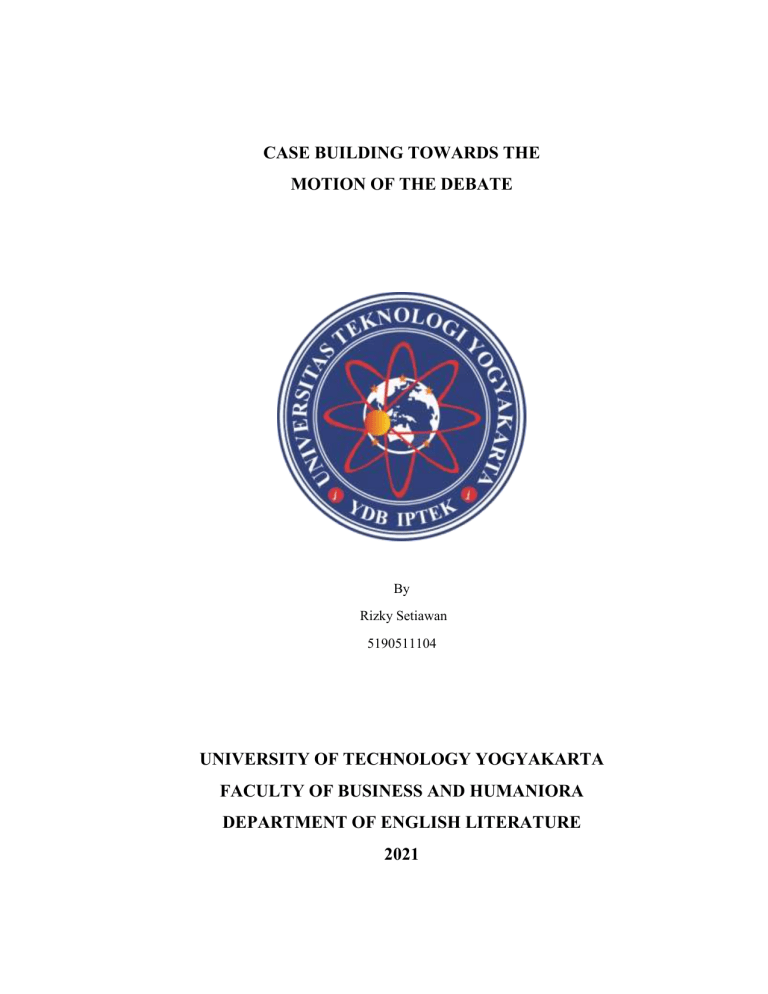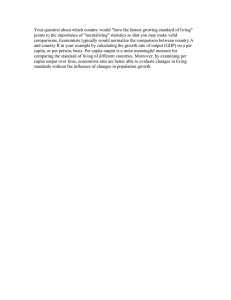
CASE BUILDING TOWARDS THE MOTION OF THE DEBATE By Rizky Setiawan 5190511104 UNIVERSITY OF TECHNOLOGY YOGYAKARTA FACULTY OF BUSINESS AND HUMANIORA DEPARTMENT OF ENGLISH LITERATURE 2021 CHAPTER I INTRODUCTION 1.1 Motion Motion : This House Believe That Child Labor is Necessary in Developing Countries. 1.2 Key Terms 1.2.1 Child Labor According to United Nations Children Fund (UNICEF) and International Labor Organization, child is categorized below the age of 18 years old (it is stated on the article 1 of the UN on the Rights of the Child). While in Indonesia, children is changed over time. Based on article 1 of Act Number 12 Year 1948, children is a male or female person aged less than or equal to 14 years old. Child labor is often defined as work that deprives children of their childhood, their potential and their dignity, and that is harmful to physical and mental development. Child labor is mentally, physically, socially or morally extremely jeopardize to children. Specifically, according to ILO (International Labor Organization), child labor is children who are prematurely leading adult lives and working long hours for low wages, under conditions which are damaging to their health and to their physical or mental development (quoted from Black (1993). 1.2.2 Necessary The term of “necessary” is the adjective form and classified as B1 level of lexical on the CEFR. It means that necessary is the needed in order to achieve a particular result (Cambridge Dictionary). The word of necessary refers to things that are needed in order to achieve certain results. Necessary, also, can be used in question to disapprove of a behavior, activity, decision and so on. Similarly, necessary can be perceived as a must or an act that is obligated to do something particular. 1.2.3 Developing Countries The term of “developing countries” can be divided into five categories, those are: 1) The Least Developed Countries (LLDC) are 29 low-income countries with per capita GNP1 (gross national product) levels below $761 (in 1998 U.S dollars) and have major issues in terms of their diversification and social development; 2) Low-Income Countries (LICs) are poor countries which meet the prior income test but do not have the same severe local conditions; 3) Lower-Middle Income (LMICs) have GNP per capita levels between $761 and $3,030; 4) Upper-Middle-Income Countries (UMICs) have annual GNP per capita levels between $3,031 and $9,360; 5) High-Income Countries (HIC have GNP per capita levels greater than $9,460 (United Nation). In simply, in terms of economics, developing country is a state with little industrial and economic activity where people generally have low incomes (Cambridge Dictionary). These are the common characteristics of Developing Nations : 1 - Low levels of national income per capita - Low levels of relative growth rates of national and income per capita - Low levels of distribution of national income - Low levels of extent of poverty GNP is an estimate of total value of all the final products and services turned out in a given period by the means of production owned by a country's residents. - Low levels of health facility - Low levels of education - Low levels of Human Development Index (HDI) There are many developing countries which are being categorized, those are : CHAPTER II DISCUSSION 2.1 Argumentation In this occasion, I firmly believe that child labor ought not to occur/regulate/needed in developing countries. Thus, I will establish the argument that is opposed to the motion in chronological order below. The limitation of this argument will only emphasize certain points, such as : - It will focuses on particular developing countries (or it depends on the Prime Minister who leads the motion where it should be focused). - Child labor policy, regarding of minimum age of child labor, will depend on the Prime Minister who leads the motion related to the legal age for children to work. (the estimate of child labor would vary depending on how they define work, how they define a child, and how they collect data) Child labor is an inappropriate act for children due to it is highly likely affects many aspects to the child and it vary environments. It can be seen from two perspective and I would like to examine it below : 1) Psychological point of view Child labor will leads to the emotional and somatic expression of wellbeing such stress, anxiety, depression, trauma, post-traumatic stress disorder and so on. For instance, a child is engaging in, or is forced to submit to, situations, activities and relationships which constitute neglect, maltreatment or abuse is an indicator of threat to that child’s current psychological well-being – whether or not the experience has repercussions for their medium or long term psychological and social adjustment. So, psychological studies can profitably address children’s ongoing experiences and current well-being as well as indicators that point to a long term impact. Furthermore, many children work in difficult circumstances for excessively long hours, without adequate rest, they are working beyond their strength, stamina and competence. Then, they will risk exhaustion and accident. Besides reducing their general wellbeing, such work can induce loss of confidence, low self-esteem and fear of punishment for poor performance. 2) Economic point of view In terms of gaining the competitive advantage of firm aim, child laboring has no specific outlook to boost the income of its firm or a state – whether it is from micro or macro perspective. Due to the child has no particular ability or adequate knowledge to do specific job desk. For instance, extensive economic activity by children can be as prejudicial to the status of adult workers, as well as inconsistent with expectations that childhood will be a period of dependency, a time for play, learning and schooling (Boyden, 1994; Fyfe, 2001). 2.2 Theme Line 1. Psychological Studies “Child labor will results depression, shame, guilt, loss of confidence, anxiety and so on”. H1 : Child labor has significant effects to the mental illness 2. Economic Studies “Child labor results in low skill workforce (uneducated) which may strongly impact the country competitiveness”. H2 : Child labor has no significant effects to the rise of Nation’s GDP Picture 1. Theoretical Framework Mental-related Illnesses Child Labor GDP 2.3 Reason and Evidence There are sort of evidences regarding of child labor in developing countries : Facts 1 : Table 1 represents the minimum age for work and the compulsory education age for different countries. Facts 2 : Facts 3 : “From an empirical analysis of Latin-American households, Dessy and Knowles (2001) document that child labor is negatively related to per capita GDP in the country of residence. They further reported that variations in GDP explain 68 per cent of the variance in child labour rates (2001). In this connection, using cross-country data, Krueger (1996) found that per capita GDP could explain 80 per cent of the worldwide cross-country variation in child labor. In China, a sharp decline in child labor occurred in the 1970s, when GDP began to rise and has been so ever since (Basu and Tzanatos 2003). Thailand experienced an annual growth rate of 9 per cent, during 1985-1995, and the labor force participation rate of children aged 13 to 14 years declined from 37 per cent in 1990 to 21 per cent in 1993 (Tzannatos 2003). In the late 1980s and the early 1990s, Vietnam enjoyed a rapid economic growth of over 6 per cent per annum especially in the last decade (Edmonds and Turk 2002), and the probability that a child aged 6 to 15 years work dropped by 26 per cent between 1993 and 1998 (Edmond 2001)” (Quoted in Khanam and Rahman, 2006). Facts 4 : Facts 5 : Facts 6 : Solution The policy implications for reducing child labor in developing countries are: government and non-government organizations must work together to improve the quality of education, with possible minimum costs, by providing better logistic supports to school going children; the government should introduce or continue targeted subsidy for poor school-going children; school curriculum must be redesigned so that it increases the probability of future employment; law of compulsory education should be staggered to a certain level; and the government and the community must work hard to reduce the overall poverty. CHAPTER III CONCLUSION I. Link Back Child labor leads the children to suffer various psychological issues while certain developing countries will get the impact of possibility to poverty due to cannot enhance their national income or GDP. Child labor is vulnerable to maltreatment and emotional abuse perpetrated by employees, supervisors, clients or others with authority and power. They are relatively isolated and powerless – forced to endure the ill treatment from employers or from other more powerful individuals from whom they might normally expect to receive nurturance, support and encouragement. Also, in terms of economics, children cannot compete with the adults who have better knowledge and stable emotion to do the desk job in workforce. Hence, child labor is an inappropriate acts and unnecessarily occurs in developing countries. REFERENCES Confederation, I. T. U. (2008). Mini action guide Child labour Definition of child labour. Iglobal Trade Union Alliance to Combat Forced Labour and Traffiking, 1(1), 46. Haszelinna binti Abang Ali, D., & Arabsheibani, G. R. (2017). Child Labour in Indonesia: Supply-Side Determinants. Economics and Finance in Indonesia, 62(3), 162. https://doi.org/10.7454/efi.v62i3.555 R Khanan, M. M. R. (2008). Child labour in developing countries: the role of education, poverty and birth order. Journal of Social and Economic Development, 10(2), 173–195. Sanford, J., & Sandhu, A. (2003). Developing countries: definitions, concepts and comparisons. 1–6. Woodhead, M. (2004). Psychosocial impacts of child work: A framework for research, monitoring and intervention. International Journal of Children’s Rights, 12(4), 321–378. https://doi.org/10.1163/1571818043603607 United Nations. (2020). World Economic Situation and Prospects. Journal of Chemical Information and Modeling, 53(9), 1689–1699. Online: https://www.ilo.org/ipec/facts/lang--en/index.htm (Accessed Online on February 27, 2021)


